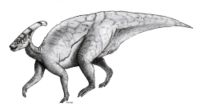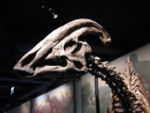Parasaurolophus
2007 Schools Wikipedia Selection. Related subjects: Dinosaurs
| iParasaurolophus |
||||||||||||||||||||||||
|---|---|---|---|---|---|---|---|---|---|---|---|---|---|---|---|---|---|---|---|---|---|---|---|---|
 Parasaurolophus walkeri
|
||||||||||||||||||||||||
| Scientific classification | ||||||||||||||||||||||||
|
||||||||||||||||||||||||
|
|
||||||||||||||||||||||||
|
P. walkeri Parks, 1922 |
Parasaurolophus was a genus of hadrosaurid (duck-billed) dinosaur from the Upper Cretaceous Period (about 76-65 million years ago) of what is now North America. Its name means 'near crested lizard', which refers to another hadrosaurid, Saurolophus, discovered before Parasaurolophus. Parasaurolophus were about 10 m (33 ft) long, 5 m (16 ft) high and weighed around 3500 kg (7,700 lb). Like other hadrosaurs, they were facultatively bipedal, i.e. they could alternate between two legs and four, probably preferring a quadrupedal gait while they foraged for food and assuming a bipedal mode for faster running.

Their most noticeable feature would have been the six-foot long curved crest, protruding from the rear of the head, often longer in males than in females. This hollow crest was probably used for intraspecific communication by both males and females and for display by the males. Many scientists also think the crest gave Parasaurolophus an excellent sense of smell. Parasaurolophus is often depicted with a flap of skin running from the bottom of the crest to the base of the neck, though there is no evidence of this. There were about three species but two of them are known only by incomplete remains. The best known species is Parasaurolophus walkeri.
Parasaurolophus probably lived in large herds and inhabited flood plains. They were herbivores but they were not, as was once thought, aquatic. They were fully terrestrial animals, as evidenced by footprints. They could possibly swim but they lived their entire lives on land. Parasaurolophus may have been prey for large carnivorous theropods, such as Daspletosaurus.
Fossils of Parasaurolophus have been found across North America and a complete skeleton was found in Canada.
In popular culture
- Parasaurolophus appeared in all three Jurassic Park films. During the Brachiosaurus scene in the first film, when the camera trails to a full view of the park, a herd is seen near the lake. Parasaurolophus appeared again in The Lost World: Jurassic Park when InGen tries to capture dinosaurs for the San Diego Jurassic Park. This dinosaur appears again in Jurassic Park III. The people on the island run into a herd of Parasaurolophus and Corythosaurus to escape Velociraptor.
- Parasaurolophus was also featured in the Vivendi Universal game Jurassic Park: Operation Genesis.
- Parasauralophus was featured in various moments of Disney's Dinosaur
- Parasauralophus also appeared in Episode 6 of ITV's documentary series Prehistoric Park.
- Parasauralophus appeared as a dinozord (Parazord) in Power Rangers Dino Thunder.
- Star Trek: Voyager featured a race called the Voth, who evolved from Parasauralophus and left Earth when they developed space technology (see " Distant Origin").
